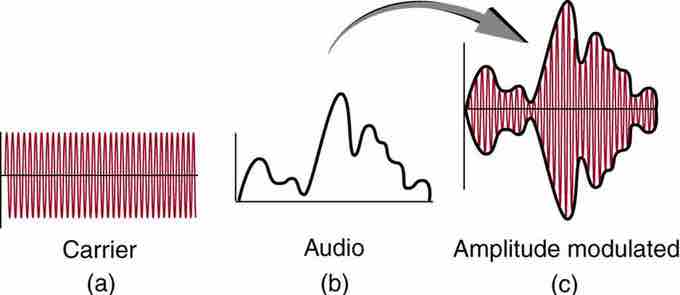Radio Waves
Radio waves are a type of electromagnetic (EM) radiation with wavelengths in the electromagnetic spectrum longer than infrared light . They have have frequencies from 300 GHz to as low as 3 kHz, and corresponding wavelengths from 1 millimeter to 100 kilometers. Like all other electromagnetic waves, radio waves travel at the speed of light. Naturally occurring radio waves are made by lightning or by astronomical objects. Artificially generated radio waves are used for fixed and mobile radio communication, broadcasting, radar and other navigation systems, communications satellites, computer networks and innumerable other applications. Different frequencies of radio waves have different propagation characteristics in the Earth's atmosphere—long waves may cover a part of the Earth very consistently, shorter waves can reflect off the ionosphere and travel around the world, and much shorter wavelengths bend or reflect very little and travel on a line of sight.
Electromagnetic Spectrum
The electromagnetic spectrum, showing the major categories of electromagnetic waves. The range of frequencies and wavelengths is remarkable. The dividing line between some categories is distinct, whereas other categories overlap. Microwaves encompass the high frequency portion of the radio section of the EM spectrum.
Types of Radio Waves and Applications
Radio waves have many uses—the category is divided into many subcategories, including microwaves and electromagnetic waves used for AM and FM radio, cellular telephones and TV.
The lowest commonly encountered radio frequencies are produced by high-voltage AC power transmission lines at frequencies of 50 or 60 Hz. These extremely long wavelength electromagnetic waves (about 6000 km) are one means of energy loss in long-distance power transmission.
Extremely low frequency (ELF) radio waves of about 1 kHz are used to communicate with submerged submarines. The ability of radio waves to penetrate salt water is related to their wavelength (much like ultrasound penetrating tissue)—the longer the wavelength, the farther they penetrate. Since salt water is a good conductor, radio waves are strongly absorbed by it; very long wavelengths are needed to reach a submarine under the surface.
AM Radio Waves
AM radio waves are used to carry commercial radio signals in the frequency range from 540 to 1600 kHz . The abbreviation AM stands for amplitude modulation—the method for placing information on these waves. A carrier wave having the basic frequency of the radio station (for instance, 1530 kHz) is varied or modulated in amplitude by an audio signal. The resulting wave has a constant frequency, but a varying amplitude.

AM Radio
Amplitude modulation for AM radio. (a) A carrier wave at the station's basic frequency. (b) An audio signal at much lower audible frequencies. (c) The amplitude of the carrier is modulated by the audio signal without changing its basic frequency.
FM Radio Waves
FM radio waves are also used for commercial radio transmission, but in the frequency range of 88 to 108 MHz . FM stands for frequency modulation, another method of carrying information. In this case, a carrier wave having the basic frequency of the radio station (perhaps 105.1 MHz) is modulated in frequency by the audio signal, producing a wave of constant amplitude but varying frequency.

FM Radio
Frequency modulation for FM radio. (a) A carrier wave at the station's basic frequency. (b) An audio signal at much lower audible frequencies. (c) The frequency of the carrier is modulated by the audio signal without changing its amplitude.
Since audible frequencies range up to 20 kHz (or 0.020 MHz) at most, the frequency of the FM radio wave can vary from the carrier by as much as 0.020 MHz. For this reason, the carrier frequencies of two different radio stations cannot be closer than 0.020 MHz. An FM receiver is tuned to resonate at the carrier frequency and has circuitry that responds to variations in frequency, reproducing the audio information.
FM radio is inherently less subject to noise from stray radio sources than AM radio because amplitudes of waves add noise. Thus, an AM receiver would interpret noise added onto the amplitude of its carrier wave as part of the information. An FM receiver can be fashioned to reject amplitudes other than that of the basic carrier wave and only look for variations in frequency. Thus, since noise produces a variation in amplitude, it is easier to reject noise from FM.
TV
Electromagnetic waves also broadcast television transmission. However, as the waves must carry a great deal of visual as well as audio information, each channel requires a larger range of frequencies than simple radio transmission. TV channels utilize frequencies in the range of 54 to 88 MHz and 174 to 222 MHz (the entire FM radio band lies between channels 88 MHz and 174 MHz). These TV channels are called VHF (very high frequency). Other channels called UHF (ultra high frequency) utilize an even higher frequency range of 470 to 1000 MHz.
The TV video signal is AM, while the TV audio is FM. Note that these frequencies are those of free transmission with the user utilizing an old-fashioned roof antenna. Satellite dishes and cable transmission of TV occurs at significantly higher frequencies, and is rapidly evolving with the use of the high-definition or HD format.